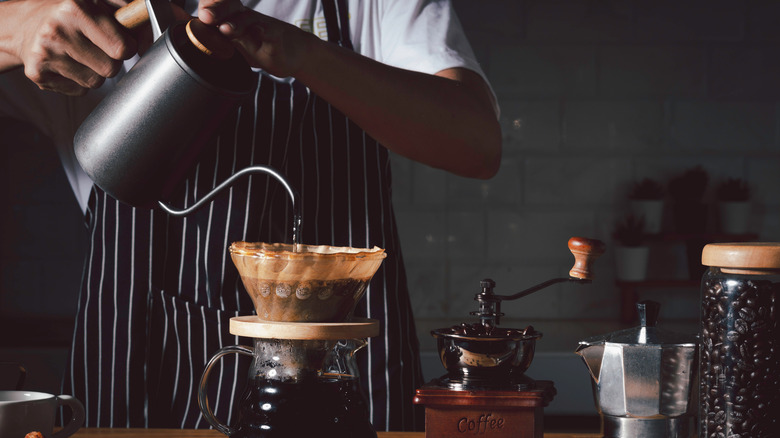What Does It Mean To Bloom Coffee And Does It Impact The Flavor?
There are plenty of ways to make coffee: Stovetop, machine-made espresso, drip coffee pots, and perhaps fancy and labor-intensive pourover coffee. Pourover coffee entails boiling hot water in a separate kettle and then pouring it slowly over a filter of ground coffee and letting it slowly filter through to brew coffee (via Espro).
This may seem simple enough, but coffee enthusiasts have gotten the method down to an exact science. Some coffee brewing aficionados have even calculated the perfect temperatures for pour-over coffee brewing: 205 degrees Fahrenheit ideally, but no cooler than 195 degrees.
Many people grind their coffee beans fresh, which is standard practice in most professional and home brewing methods. Some people will even weigh out their fresh and ground beans for the best pourover (via Creators of Coffee). They also take time to bloom their coffee, a process that helps your pourover coffee taste even more delicious.
Releasing carbon dioxide
Blooming coffee may seem like an unnecessary, showy step in the brewing process, but it actually does a lot to enhance the flavor of your coffee and the smoothness of the brewing process. According to Serious Eats, blooming coffee refers to the process of releasing carbon dioxide that gets stuck in the beans during the roasting process.
Blooming coffee just involves adding some hot water to the coffee grounds: Not enough to start brewing the coffee, but enough to wet the ground coffee. After roughly 30 to 45 seconds, the coffee grounds will start releasing bubbles to the surface, which is a sign of the carbon dioxide being released.
Once it's degassed/the carbon dioxide has been released, you can slowly pour the rest of your hot, boiling water over the grounds. Carbon dioxide doesn't impact the flavor of the beans, but it prevents water from fully permeating the grounds, which means you may not get all the delicious, rich coffee flavor you can from the coffee. Once the carbon dioxide has been released, it leads to coffee that is even more potently flavorful, and the brewing process is a lot cleaner and smoother.

